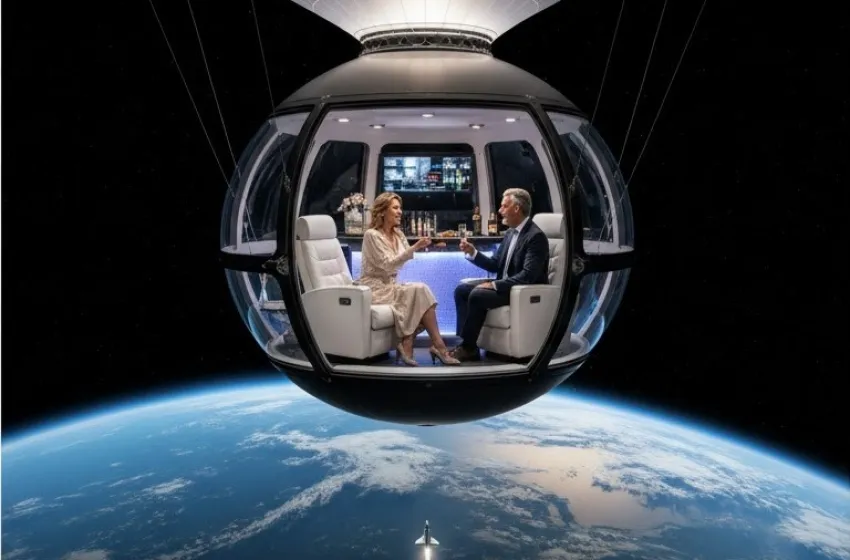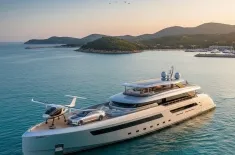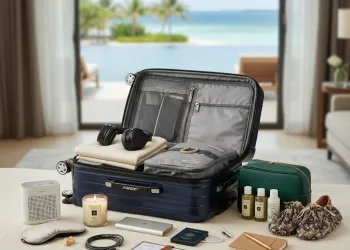Experience the ultimate luxury with suborbital flights, near-space balloon travel, and orbital hospitality.
The final frontier is rapidly transforming from the exclusive domain of astronauts and governmental agencies into the ultimate destination for the world’s ultra-affluent. Luxury space tourism represents the pinnacle of experiential travel, offering not just a journey, but a profound shift in perspective that redefines luxury itself. This emerging sector encompasses two primary tiers: the brief, high-octane thrill of suborbital flights and the serene, yet equally exclusive, journeys known as near-space balloon travel and high-altitude travel. Together, these options are fueling the commercialization of extreme high-altitude and suborbital experiences for ultra-affluent clientele, creating a multi-billion dollar market that is set to expand exponentially in the coming decade.
The Commercialization of Extreme High-Altitude and Suborbital Experiences
The pivot from government-funded missions to private, commercial ventures is the single most important factor driving this luxury market. Companies like SpaceX, Blue Origin, Virgin Galactic, and Space Perspective have successfully de-risked and modularized space access, transforming bespoke launches into scalable, though still highly exclusive, travel products.
Targeting the Ultra-Affluent Market
The core market for these experiences is the Ultra-High-Net-Worth Individual (UHNWI)—individuals with a net worth of over $30 million. For this demographic, traditional luxury experiences—superyachts, private islands, and customized jets—have become commonplace. Space tourism offers something genuinely novel and inherently scarce: a once-in-a-lifetime, profound, and public display of adventure and means. The prices, ranging from hundreds of thousands of dollars for suborbital flights to tens of millions for orbital trips, naturally create a barrier of entry that guarantees exclusivity.
Companies market these journeys not as mere travel, but as "experiential philanthropy" or "citizen scientist missions," providing a higher purpose that resonates with wealthy individuals who often seek to link their expenditures to meaningful endeavors. The opportunity to see the "Overview Effect"—the cognitive shift in awareness reported by astronauts when viewing Earth from space—is presented as an investment in a new global perspective.
The Two Tiers of the Luxury Space Experience
The market is segmented based on altitude, duration, and the level of G-forces experienced, catering to different affluent customer preferences for adventure versus serenity.
Suborbital Flights: The High-Octane Thrill
Suborbital flights, offered by companies like Virgin Galactic and Blue Origin, are rocket-powered journeys designed to cross the internationally recognized boundary of space—the Kármán line, approximately 100 kilometers (62 miles) above sea level—before immediately returning to Earth.
The Experience: These are 90-minute to two-hour missions where the climax involves several minutes of weightlessness (microgravity) and a breathtaking view of the Earth's curvature against the blackness of space.
The Luxury Offering: The value lies in the exclusive aerial experiences of the launch, the weightlessness, and the highly personalized, high-touch training programs. Virgin Galactic's "Future Astronaut" program, for example, provides bespoke preparation and community-building among fellow travelers.
Near-Space Balloon Travel: Serene Altitude
A gentler, yet equally awe-inspiring alternative is near-space balloon travel. Companies like Space Perspective (with their Spaceship Neptune) and World View offer slow, luxurious ascents to the stratosphere, reaching altitudes of around 100,000 to 120,000 feet (19-23 miles). This is significantly below the Kármán line but high enough to see the curvature of the Earth and the thin blue line of the atmosphere.
The Experience: These are six-hour journeys—two hours up, two hours cruising at peak altitude, and two hours down. The capsule is pressurized and features panoramic windows, a bar, and even a restroom, offering a relaxed and comfortable high-altitude travel experience that requires no special G-force training.
The Luxury Offering: The focus here is on orbital hospitality and extended, tranquil viewing time. It is marketed as a serene, exclusive aerial experience—a "space-lounge" trip—appealing to the segment of the ultra-affluent who prioritize comfort and reflection over G-force thrills.
Orbital and Lunar Aspirations: The Ultimate Luxury
Beyond the edge of space, the truly ultimate luxury experience is orbital hospitality. While suborbital flights are costly, orbital space tourism—a trip to Low Earth Orbit (LEO) or a stay on a private space station—costs in the tens of millions of dollars.
The Rise of Orbital Hotels
Companies like Axiom Space, in partnership with SpaceX, are facilitating private astronaut missions to the International Space Station (ISS), with plans to launch their own modular commercial space station. This vision represents the future of orbital hospitality: luxury space hotels with Earth-viewing cupolas, gourmet catering, and extended stays that redefine the concept of a "destination."
The shift here is from a quick viewing experience to a fully immersive, multi-day or multi-week residency in space.
Lunar and Deeper Space Tourism
Looking further ahead, companies like SpaceX are already booking seats for private lunar flyby missions (e.g., the dearMoon project). These voyages, priced at an astronomical level, push the boundaries of space tourism beyond Earth's orbit and into the realm of interplanetary adventure—the final, most exclusive frontier for the world's most daring pioneers..
The Path Forward: Innovation and Exclusivity
The convergence of technological advancement, massive private investment, and insatiable demand from the world’s wealthiest has firmly established luxury space tourism as the ultimate luxury market.
The dual approach of rocketing suborbital flights and serene near-space balloon travel ensures that companies cater to different risk and comfort profiles within the ultra-affluent demographic. While one offers the brief, intense thrill of weightlessness, the other provides an extended, contemplative exclusive aerial experience of seeing the planet from above. Both, however, deliver on the promise of scarcity.
The future of this sector will be defined by innovation that enhances the comfort, safety, and exclusivity of the journey. This includes the development of reusable launch systems to increase flight frequency, the creation of dedicated spaceports, and the construction of purpose-built private space stations designed specifically for orbital hospitality. As these developments mature, the competition will intensify, but the core product—access to an experience that few humans have ever shared—will remain the ultimate signifier of ultra-luxury. The journey to the edge of space, and beyond, is officially open for private business.









![Resort Deep Dive: In-Depth Review Of [Specific Luxury Resort]](https://habertalya.com/img/view/general/2025/11/b/99c81c78-b1a2-4165-b970-1822a3d8561e-travel_235x155.webp)

























